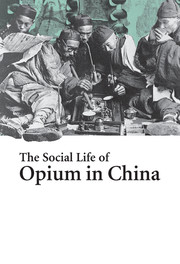Book contents
- Frontmatter
- Contents
- List of illustrations
- List of maps
- List of tables
- Acknowledgements
- Introduction
- 1 ‘The art of alchemists, sex and court ladies’
- 2 As the empire changed hands
- 3 ‘The age of calicoes and tea and opium’
- 4 ‘A hobby among the high and the low in officialdom’
- 5 Taste-making and trendsetting
- 6 The political redefinition of opium consumption
- 7 Outward and downward ‘liquidation’
- 8 ‘The volume of smoke and powder’
- 9 ‘The unofficial history of the poppy’
- 10 Opiate of the people
- 11 The road to St Louis
- 12 ‘Shanghai vice’
- Conclusion
- Notes
- Glossary
- Bibliography
- Index
1 - ‘The art of alchemists, sex and court ladies’
Published online by Cambridge University Press: 05 June 2012
- Frontmatter
- Contents
- List of illustrations
- List of maps
- List of tables
- Acknowledgements
- Introduction
- 1 ‘The art of alchemists, sex and court ladies’
- 2 As the empire changed hands
- 3 ‘The age of calicoes and tea and opium’
- 4 ‘A hobby among the high and the low in officialdom’
- 5 Taste-making and trendsetting
- 6 The political redefinition of opium consumption
- 7 Outward and downward ‘liquidation’
- 8 ‘The volume of smoke and powder’
- 9 ‘The unofficial history of the poppy’
- 10 Opiate of the people
- 11 The road to St Louis
- 12 ‘Shanghai vice’
- Conclusion
- Notes
- Glossary
- Bibliography
- Index
Summary
This chapter follows the early life of opium, from 1483 up until the end of the Ming dynasty and the start of the Qing dynasty. In July 1405 a fleet of sixty-three treasure ships with more than 27,870 crew members and 255 smaller vessels left the port of Nanjing under the helmsmanship of the eunuch-admiral Zheng He. This was the third year of the Yongle emperor's reign (1403–24), and the trip was the first of seven epic expeditions Zheng would make with 317 ships between 1405 and 1433. The fleet called on many ports in the South China Sea and the Indian Ocean, from Surabaja and Chittagong to Calicut, from Hormuz and Jidda to Mombasa. In 1418 Zheng moored off the coast of Malindi with junks full of porcelain, silk, lacquer-ware and other fine art objects to trade for the things China prized: ivory, rhinoceros horn, tortoiseshell, medicines and precious stones. It was eighty years before Vasco da Gama would round the Cape of Good Hope. Zheng and his fleet were goodwill ambassadors of the Ming dynasty. The expeditions projected China as the benevolent Celestial Empire; they reinforced the role of the Middle Kingdom and strengthened China's ties with south, south-east Asia and the world beyond. The ties that were created were both political and genealogical, maintained by tribute when tribute was diplomacy and by coastal people when seafaring was a way of life.
- Type
- Chapter
- Information
- The Social Life of Opium in China , pp. 10 - 24Publisher: Cambridge University PressPrint publication year: 2005



